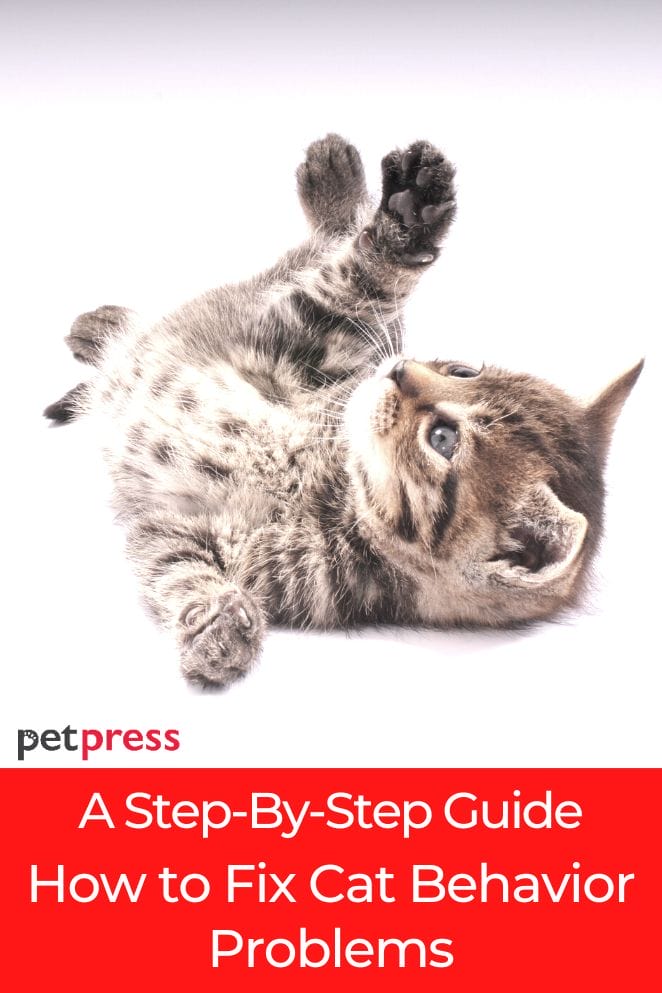
Greetings to all fellow cat aficionados!
Cats, as we know, are extraordinary creatures, but at times, their behavior can pose a few challenges.
If you find yourself grappling with a mischievous feline friend, fear not.
This blog post aims to be your compass, helping you comprehend and manage those vexing cat behavior dilemmas.
We’ll delve into the common signs of disruptive cat behavior and provide practical solutions to transform your cat into a well-mannered family member.
So, let’s embark on this enlightening journey!
Recognizing Signs of Disruptive Behavior in Cats
Before we can address cat behavior issues, it’s essential to recognize the signs.
Cats are known for being independent, but sometimes they exhibit behavior that may raise concerns.
Here are some common indicators:
Aggression
When a typically mild-mannered cat exhibits sudden aggression, it’s essential to take notice.
Aggressive actions like hissing, scratching, or biting may signify an underlying problem or distress.
It’s crucial to observe these signals and investigate their root causes
Excessive meowing
While cats are naturally vocal, excessive meowing should raise concern.
It can be an indicator of stress, loneliness, or even a medical issue.
When your cat’s meowing becomes incessant, it’s vital to address the underlying reasons.
This may involve offering more companionship, reducing sources of stress, or seeking professional veterinary care.
Inappropriate litter box
If your cat starts using areas outside the litter box, it’s a clear sign of trouble.
This behavior may result from stress, discomfort, or underlying medical issues.
Prompt action is necessary to identify and resolve the problem, both for your cat’s health and your home’s cleanliness.
Destructive scratching
Cats have a natural inclination to scratch, which helps maintain their claws and mark territory.
However, when this behavior leads to the destruction of furniture or belongings, it becomes a problem.
Properly managing this behavior through scratching posts and training is essential to preserve your possessions and keep your cat content.
Hiding or isolation
While cats do enjoy occasional alone time, persistent hiding or isolation may indicate unhappiness or anxiety.
Pay attention to your cat’s need for solitude, but also ensure they have access to social interaction and a safe, comfortable environment.

Common Cat Behavior Problems
Now that we’ve identified the signs, let’s explore some of the most common cat behavior problems:
Separation anxiety
Cats can experience anxiety when their beloved humans are away.
This can lead to destructive behaviors or excessive meowing.
To mitigate this, shower your feline friend with affection when you’re at home.
Create a calm routine around departures and arrivals, and consider offering toys or comfort items in your absence.
Territorial aggression
Cats are territorial by nature, and if they feel their domain is under threat, they may act out.
Ensure your cat has plenty of space to call their own, with cozy hiding spots and elevated perches.
This can help reduce territorial conflicts with other pets or even within a multi-pet household.
Litter box problems
If your cat is avoiding the litter box, it could be due to issues with the box itself or a medical problem.
Maintain a clean litter box and choose a suitable location.
If problems persist, consult your veterinarian to rule out any underlying health concerns.
Boredom
Cats need both mental and physical stimulation.
A lack of toys and playtime can lead to destructive behaviors.
Invest in interactive toys and engage in regular play sessions to keep your cat mentally and physically engaged.
Puzzle feeders can also help stimulate their minds.
Medical issues
In some cases, behavioral issues may be an indicator of underlying medical conditions.
If you observe sudden changes in your cat’s behavior, like increased aggression or unusual litter box habits, it’s imperative to consult your veterinarian.
They can conduct a comprehensive examination and diagnostic tests to rule out any medical issues.
How to Fix Cat Behavior Problems

Now, let’s get to the good stuff – how to fix these cat behavior problems and have a harmonious life with your feline friend.
Positive reinforcement
Reward your cat when they exhibit desirable behavior.
Cats respond well to positive reinforcement in the form of treats and affection.
This helps reinforce their good actions and encourages them to continue these behaviors.
Training
Cats can be trained to modify their behavior.
For instance, you can teach them to use the litter box or deter them from scratching furniture.
Be patient during training, and always use positive reinforcement to reward correct actions.
Provide mental stimulation
Cats thrive on mental challenges. Invest in puzzle toys, interactive feeders, or laser pointers to keep your cat mentally engaged.
These activities not only ward off boredom but also enhance their cognitive abilities.
Create safe spaces
Cats need their own sanctuaries where they can retreat when they need a break.
Provide cozy hiding spots or cat trees with elevated perches where they can observe their surroundings from a safe vantage point.
These safe spaces offer comfort and security.
Consult a professional
If you’re grappling with your cat’s behavior issues despite your best efforts, do not hesitate to turn to a professional cat behaviorist or trainer for assistance.
These experts specialize in providing customized advice and solutions to tackle complex behavior challenges.
Conclusion
In the end, it’s vital to approach cat behavior problems with patience and empathy.
Cats may not always align with our expectations, but with a thoughtful strategy, you can nurture a deep and affectionate bond with your feline companion.
Pay attention to their needs, apply positive reinforcement, and create a stimulating environment.
Your cat will express their gratitude through purrs and loving affection.
FAQs
It’s not recommended to use punishment as it can create fear and stress in your cat. Positive reinforcement is a more effective and humane approach.
The timeline for improvements varies from cat to cat. Some may show progress in a few weeks, while others might take a few months. Be patient and consistent with your efforts.
If you suspect a medical issue, consult your veterinarian. Addressing any underlying health concerns is essential before addressing behavioral problems.
Yes, older cats can be trained, but it may take more time and patience. It’s never too late to work on improving your cat’s behavior.
- Essential Oils Safe for Cats: What Every Pet Owner Needs to Know - May 23, 2025
- Herbal Supplements for Cats: A Natural Approach to Cat Wellness - May 21, 2025
- Signs of a Healthy Cat Coat: What Every Cat Owner Should Know - May 19, 2025


GIPHY App Key not set. Please check settings